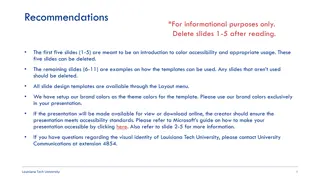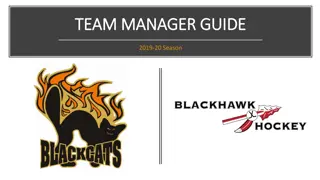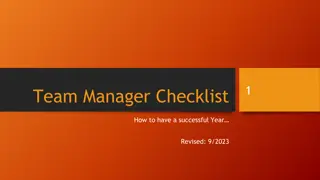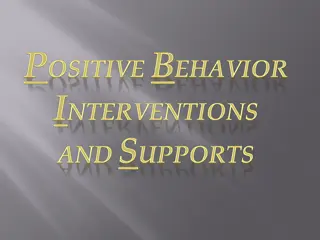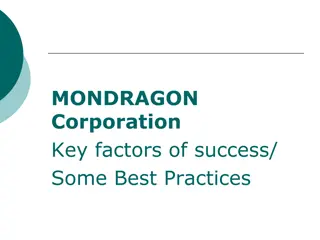Strategies for Success as a Manager of Color
Addressing the challenges of being a manager of color requires a proactive approach. Develop your management style, understand your organization's culture, prioritize clear communication, and combat unconscious bias. Cultivate personal strategies to navigate and succeed in the workplace.
Download Presentation

Please find below an Image/Link to download the presentation.
The content on the website is provided AS IS for your information and personal use only. It may not be sold, licensed, or shared on other websites without obtaining consent from the author. Download presentation by click this link. If you encounter any issues during the download, it is possible that the publisher has removed the file from their server.
E N D
Presentation Transcript
Five Strategies for Addressing the Challenges of Being a Manager of Color Leading to Win in Your Workplace Panelists: Rahwa Ghebre-Ab, Esq., Senior Vice President, Business & Legal Affairs, Lionsgate Entertainment Valerie Kennedy, Esq., Special Counsel, Cravath, Swaine & Moore, LLP
Understanding the Management Landscape The Primary Goals of Management Leadership is the art and science of getting things done through people. (-Mary Parker Follett)
#1 Determine and Develop Your Management Style Set Objectives and Monitor Progress Establish both management and team objectives Level-set expectations of what success looks like with both your manager and your team (key performance indicators, etc.) Monitor team performance, strategy, client value-creation and overall team effectiveness Plan your work; have a roadmap with key milestones
What is Your Management Style? Are you communicative and collaborative? Do you micromanage? Who are you most comfortable with? Do you show a preference towards them? Do you delegate well or take on everything yourself? Do you have an executive coach?
#1 Determine and Develop Your Management Style Know Your Organization Know your organization s culture and decision-making Framework: What traits or practices are valued? Who makes things happen? How are decisions made and what processes are involved? Be aligned with the company s priorities and chief goals
#1 Determine and Develop Your Management Style Communication Is Key Be clear on your communication style Malleability is a strength! Be alert to team communication style Not everyone receives the same message in the same way Invest in professional growth & team building Insights, Meyers Briggs, etc. Seek feedback
#2 Cultivate Your Personal Strategies for Combatting Unconscious Bias Examples: Double standards for performance Microaggressions from peers and direct reports Managing team members of color Marginalization or exclusion within key communication loops Compensation and decision-making equity Access to Old Boy & Old Girl networks
#2 Cultivate Your Personal Strategies for Combatting Unconscious Bias Assess And Set The Tone Does management welcome and value remedying unconscious bias? Do you want to be involved in D&I? Are you forced to be involved with Company D&I initiatives? Practice self-aware decision-making Promote self-aware decision-making Do not allow your experience with unconscious bias to impact your team negatively Know when to walk away
#2 Cultivate Your Personal Strategies for Combatting Unconscious Bias DEVELOP a values driven and objectives focused management style IDENTIFY a thought partner and mentor for advice and counsel BUILD your company brand and allies TALK with your HR and/or D&I team(s) about constructive ways to address bias through training and engagement (if you so choose!) ASK to be included and valued DOCUMENT successes and breakthroughs
Question Break! Assessing one s management style and reflection on unconscious bias requires candid self-assessment and confidential third party feedback, if possible: What or who triggers self doubt or frustration for you at work? How do you deal with it? Have you contributed towards difficult dynamics?
Do You Have High EQ or Situational Awareness? Are you alert enough to how others may perceive you? Do you understand the importance of impression/reputation management? Are you able to effectively read a room or discern when race or gender are not factors in a problem or situation? Are you struggling with Imposter Syndrome or Corporate Stockholm Syndrome Is your antenna off as a result?
#3 Be Clear (Or Get Clear!) On The Value You Add Don t focus on how others are not bringing value focus on how you are How do you create value? (ex. content programming, diligent follow-through, engagement on company committees) Do you actively work on staying ahead of the curve competitively and as a knowledgeable manager? Are you working to build social capital and alliances? What is your network like? Who is in it?
#4 Do Your Best To Bring Your Values and Your Professional Self To Work Merge your professional authenticity with your personal values How do you define authenticity? How is authenticity weaponized?
#5 Prepare A Guidemap Moving Forward Recognize and have a plan of attack for stumbling blocks protect your flank! Have a work plan or strategic plan that connects the dots for team members and leadership Execute key deliverables Develop next gen skills Spend time listening to direct reports and peers Engage in Self Care
THANK YOU! Contact Information: Rahwa Ghebre-Ab: E-Mail: rghebreab@lionsgate.com LinkedIn: https://www.linkedin.com/in/rahwaghebreab/ Valerie Kennedy: E-Mail: rghebreab@lionsgate.com LinkedIn: https://www.linkedin.com/in/rahwaghebreab/









